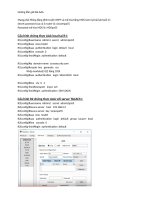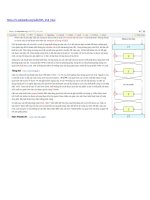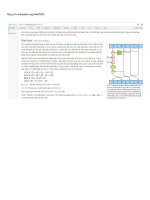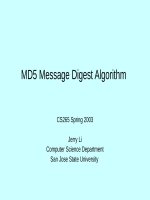Tài Liệu - Võ Tấn Dũng (votandung) MD5
Bạn đang xem bản rút gọn của tài liệu. Xem và tải ngay bản đầy đủ của tài liệu tại đây (411.95 KB, 12 trang )
MD5 Algorithm
Harley Kozushko
Harley Kozushko
11/28/2003
1
Opening
• MD5 algorithm can be used as a digital
signature mechanism.
• This presentation will explore the
technical aspects of the MD5 algorithm.
Harley Kozushko
11/28/2003
2
Description of the MD5 Algorithm
• Takes as input a message of arbitrary length and
produces as output a 128 bit “fingerprint” or
“message digest” of the input.
• It is conjectured that it is computationally infeasible
to produce two messages having the same
message digest.
• Intended where a large file must be “compressed”
in a secure manner before being encrypted with a
private key under a public-key cryptosystem such
as PGP.
Harley Kozushko
11/28/2003
3
MD5 Algorithm
• Suppose a b-bit message as input, and
that we need to find its message digest.
Harley Kozushko
11/28/2003
4
MD5 Algorithm
• Step 1 – append padded bits:
– The message is padded so that its length is
congruent to 448, modulo 512.
• Means extended to just 64 bits shy of being of
512 bits long.
– A single “1” bit is appended to the message,
and then “0” bits are appended so that the
length in bits equals 448 modulo 512.
Harley Kozushko
11/28/2003
5
MD5 Algorithm
• Step 2 – append length:
– A 64 bit representation of b is appended to
the result of the previous step.
– The resulting message has a length that is
an exact multiple of 512 bits.
Harley Kozushko
11/28/2003
6
MD5 Algorithm
• Step 3 – Initialize MD Buffer
• A four-word buffer (A,B,C,D) is used to
compute the message digest.
– Here each of A,B,C,D, is a 32 bit register.
Harley Kozushko
11/28/2003
7
MD5 Algorithm
• Step 3 cont.
• These registers are initialized to the
following values in hexadecimal:
word A: 01 23 45 67
word B: 89 ab cd ef
word C: fe dc ba 98
word D: 76 54 32 10
Harley Kozushko
11/28/2003
8
MD5 Algorithm
• Step 4 – Process message in 16-word blocks.
– Four auxiliary functions that take as input three 32-bit
words and produce as output one 32-bit word.
F(X,Y,Z) = XY v not(X) Z
G(X,Y,Z) = XZ v Y not(Z)
H(X,Y,Z) = X xor Y xor Z
I(X,Y,Z) = Y xor (X v not(Z))
Harley Kozushko
11/28/2003
9
MD5 Algorithm
• Step 4 – Process message in 16-word
blocks cont.
– if the bits of X, Y, and Z are independent and
unbiased, the each bit of F(X,Y,Z), G(X,Y,Z),
H(X,Y,Z), and I(X,Y,Z) will be independent
and unbiased.
Harley Kozushko
11/28/2003
10
MD5 Algorithm
• Step 5 – output
– The message digest produced as output is
A, B, C, D.
– That is, output begins with the low-order byte
of A, and end with the high-order byte of D.
Harley Kozushko
11/28/2003
11
Summary
• The MD5 algorithm is simple to
implement, and provides a “fingerprint” or
message digest of a message of arbitrary
length.
• The difficulty of coming up with two
messages with the same message digest
is on the order of 2^64 operations.
Harley Kozushko
11/28/2003
12









